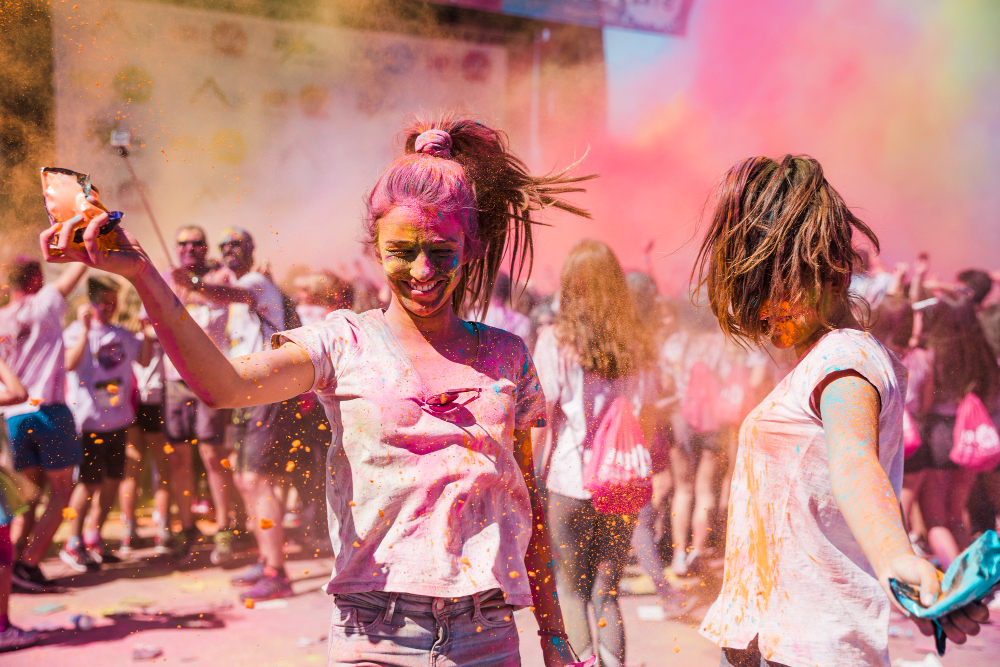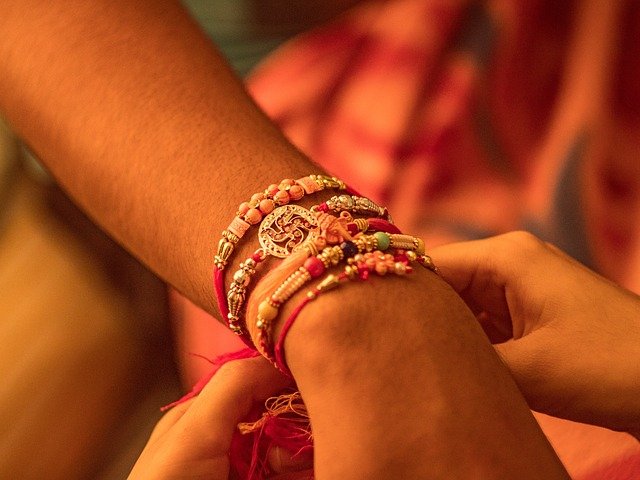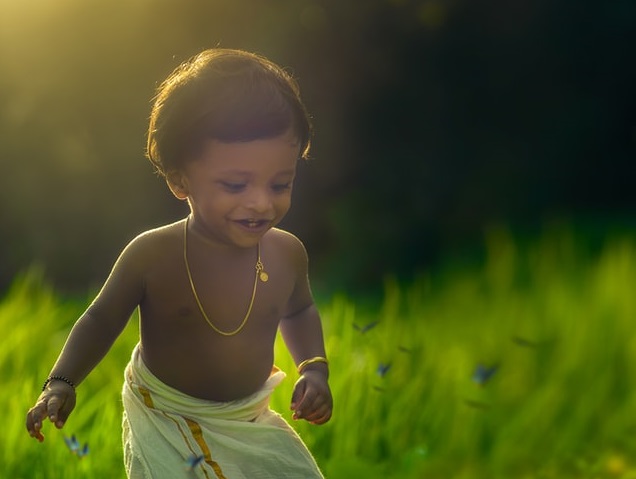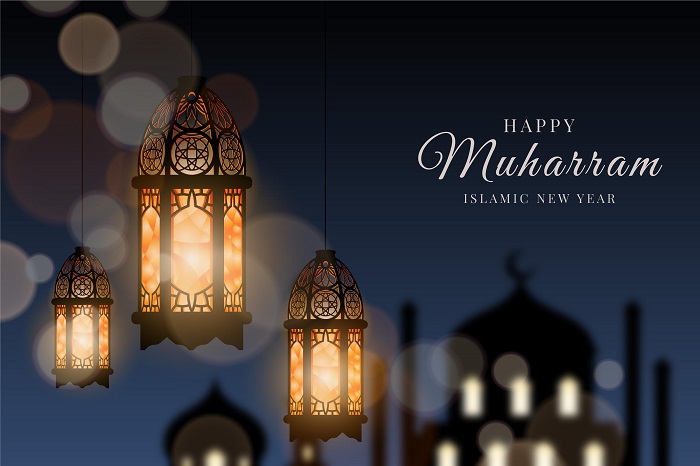holi-day

Holi, India’s festival of colours, is symbolic of good reigning above evil
Holi, India’s festival of colours, is symbolic of good reigning above evil. Holi is celebrated around India by all ages and communities with great vibrance and enthusiasm. It also symbolises the onset of Spring in some parts of India. And hence corroborates a thanksgiving for a good harvest and fulfilment.
Holi is in essence an extremely light-hearted festival, where families and communities put their troubles away and come together for day of pure fun. Holi is traditionally celebrated with colour powder and sometimes water dyed with colour too. It is recommended, to wear old clothes and to rub hair oil or coconut oil into your hair and skin beforehand, to prevent the color from absorbing.
When is Holi Celebrated?
Like most Hindu festivals, Holi follows the pattern of the lunar calendar. Holi is the day after the full moon in March each year. The equivalent festival in West Bengal and Odisha, Dol Jatra or Dol Purnima, in eastern parts of India falls a day earlier. In some parts of India though, Holi festivities start almost a week in advance.
Hindu Mythological Significance of Holi
According to Vedic literature, Holi is associated with the obliteration of the demoness Holika by Lord Vishnu known as “The Preserver”. Thereby restoring peace and preventing evil. According to the story, Holika's brother, the demon King Hiranyakashyap, had ordered Holika to burn his own son, Prahlad, due to his allegiance to Lord Vishnu and not him. Holika, thinking herself to be impervious to fire, sat with the son Prahlad on her lap, in the burning fire. However, she was burned to death while Prahlad remained alive because of his devotion to Lord Vishnu.
There is another mythological association is the word “Holi”. Lord Vishnu is thought to be reincarted as Lord Krishna. Krishna loved to play pranks and there are incidents of Krishna, as a child, smearing colours on village girls and drenching them with water. Hence the name "Festival of Colors".
In Orissa and West Bengal, however, the celebrations are different. Termed as “Dol Jatra”, it also celebrates Lord Krishna. In this region the festivities revolve around the love that Krishna is believed to have expressed to his consort, Radha on this particular day. Processions of the Idols of Radha and Krishna which are specially decorated are lifted and carried around. The idols are also smeared with Holi or color powder.
Traditional ways to celebrate Holi
While Holi is celebrated almost all over India, the level of energy and certain traditions vary. Holi revolves around Lord Krishna, hence it is expected that the heart of Holi celebrations take place in his birthplace, Mathura and Vrindavan. Here a week-long celebration ensues and is usually a hot bed for tourist activity during this time.
The week before Holi is termed as Lathmar. This literally translates to 'hitting with sticks'. During this period, the women of Barsana, the birth place of Hindu God Krishna’s beloved Radha, beat the men from Nandgaon, the hometown of Hindu God Krishna, with wooden sticks in response to their efforts to throw colour on them.
On the day just before Holi, large bonfires are lit to symbolise the burning of Hollika. This day is called Holika Dahan. A special puja is conducted and followed by singing and dancing around the fire.
The main day of Holi is called Rangwali Holi or Badi Holi. On this the day, people gather in groups and run around and apply colours to one another. You might even find groups of people with drums and other musical instruments on streets, dancing and singing traditional Holi songs.
Gujiya is a special sweet, which is made in every household in India during Holi. It is a deep-fried wheat dumpling filled with thickened sweet milk and dried fruits. The customary drink of Holi is thandai, which generally contains bhang.
Modern Holi Celebrations
People spend the day throwing and playing with Holi or colored powder. They smear it all over each other's faces and even spray colored water on each other. Holi parties include dancing under water sprinklers, sweets, delicious food, like gol gappe, papri chaat, dal kachori, kanji vada, dahi bhalle, chole bhature, and variety of namkeen.
Special Holi events with music, rain dances, and colors are organized by Hotels and Community centers in large cities across India. Young and older kids play in groups with dry colours, water guns, and throw balloons filled with coloured water.
Unlike most other festivals in India, there are not many religious rituals to be performed on the main day of Holi. It is simply a day for having fun!
होली कैसे मनाये? भारत के रंगों का त्योहार
होली, भारत का रंगों का त्योहार, बुराई के ऊपर अच्छाई की जीत का प्रतीक है। सभी उम्र और समुदायों द्वारा बहुत उत्साह के साथ चारों ओर होली मनाई जाती है। यह भारत के कुछ हिस्सों में वसंत की शुरुआत का प्रतीक भी है। और इसलिए एक अच्छी फसल के लिए धन्यवाद देने का अवसर भी है।
होली संक्षेप में एक बेहद ही हर्षोल्लास का त्योहार है, जिसमें परिवार और समुदाय अपनी परेशानियों को दूर करने और मनोरंजन के लिए एक साथ आते हैं। होली पारंपरिक रूप से रंग के साथ मनाई जाती है और कभी-कभी पानी रंग से रंगा भी जाता है। पुराने कपड़े पहने जाते हैं और रंग से बचने के लिए अपने बालों और त्वचा में पहले से ही तेल या नारियल तेल लगाया जाता है।
होली कब मनाई जाती है?
अधिकांश हिंदू त्योहारों की तरह, होली चंद्र कैलेंडर के पैटर्न का अनुसरण करता है। होली मार्च में पूर्णिमा के बाद का दिन है। पश्चिम बंगाल और ओडिशा में समतुल्य त्योहार, डोल जात्रा या डोल पूर्णिमा, भारत के पूर्वी हिस्सों में पूर्णिमा से एक दिन पहले पड़ती है। भारत के कुछ हिस्सों में हालांकि, होली का त्योहार लगभग एक सप्ताह पहले शुरू हो जाता है।
होली का हिंदू पौराणिक महत्व
वैदिक साहित्य के अनुसार, होली भगवान द्वारा दानव होलिका के विस्मरण के साथ जुड़ा हुआ है, विष्णु को "संचालक" के नाम से जाना जाता है। जिससे शांति बहाल हो और बुराई को रोका जा सके। कहानी के मुताबिक, होलिका के भाई, राक्षस राजा हिरण्यकश्यप ने होलिका को अपने ही पुत्र प्रहलाद को भगवान विष्णु के प्रति उनकी निष्ठा के कारण जलाने का आदेश दिया था। होलिका, खुद को अभेद्य समझकर जलाने के लिए पुत्र प्रहलाद को गोद में लेकर जलती आग में बैठ गयी। हालाँकि, वह जलकर मर गई, जबकि भगवान विष्णु की भक्ति के कारण प्रह्लाद जीवित रहा।
एक और पौराणिक महत्व है "होली" शब्द का। माना जाता है कि भगवान विष्णु पुनर्जन्म लेकर भगवान कृष्ण के रूप में आए। कृष्ण को मज़ाक करना पसंद था और कृष्ण की घटनाएँ हैं, एक बाल रूप में, मुस्कुराते हुए गाँव की लड़कियों पर रंग डालकर उन्हें पानी से सराबोर करने की। इसलिए नाम “रंगों का त्योहार” पड़ गया।
उड़ीसा और पश्चिम बंगाल में, हालांकि, समारोह अलग हैं। इसे "डॉल जात्रा" भी कहते हैं और भगवान कृष्ण को मनाते हैं। इस क्षेत्र में उत्सव प्रेम के इर्द-गिर्द घूमता है, माना जाता है कि इस दिन विशेष रूप से कृष्ण ने राधा को अपना प्रेम व्यक्त किया। राधा और कृष्ण की मूर्तियों के जुलूस, जिन्हें विशेष रूप से सजाया जाता है, उन्हें उठाकर इधर-उधर ले जाया जाता है। मूर्तियों पर भी होली में रंग का पाउडर डाला जाता है।
होली मनाने के पारंपरिक तरीके
जबकि होली लगभग पूरे भारत में मनाई जाती हहै जगह—जगह ऊर्जा का स्तर और कुछ परंपराएं अलग हैं। होली भगवान कृष्ण से संबंधित है, इसलिए यह लाज़मी है कि होली समारोह का उनकी जन्मभूमि, मथुरा और वृंदावन, में विशेष महत्व है। यहाँ एक सप्ताह का उत्सव मनाया जाता है और आमतौर पर इस दौरान पर्यटक गतिविधि होती है।
होली के एक सप्ताह पहले को लठमार कहा जाता है। यह शाब्दिक रूप से “लाठी से मारना” है। इसके दौरान, हिंदू भगवान कृष्ण की प्यारी राधा के जन्म स्थान बरसाना की महिलायें नंदगाँव से पुरुषों को लकड़ी के डंडे के साथ मारने और उन पर रंग फेंकने का प्रयास करती हैं।
होली के ठीक एक दिन पहले होलिका जलाने के प्रतीक के लिए बड़े-बड़े अलाव जलाए जाते हैं। यह दिन है जिसे होलिका दहन कहा जाता है। एक विशेष पूजा आयोजित की जाती है और उसके बाद अग्नि के चारों ओर नाच-गाना किया जाता है।
होली के मुख्य दिन को रंगवाली होली या बड़ी होली कहा जाता है। इस दिन, लोग समूहों में इकट्ठा होते हैं।
और चारों ओर एक दूसरे को रंग लगाते हैं। आपको सड़कों पर ड्रम और अन्य संगीत वाद्ययंत्र वाले लोगों के समूह भी मिल सकते हैं, नृत्य और पारंपरिक होली गीत गाते हुए।
गुजिया एक विशेष मिठाई है, जो होली के दौरान भारत के हर घर में बनाई जाती है। यह तला हुआ गेहूं के पकौडा है जो गाढ़े मीठे दूध और सूखे मेवों से भरे होते हैं। होली का प्रथागत पेय ठंडई है, जिसमें आम तौर पर भांग होता है।
आधुनिक होली समारोह
लोग होली या रंगीन पाउडर को फेंकने और खेलने में दिन बिताते हैं। वे सब के चहरे पर रंगीन पानी का छिड़काव करते हैं। होली पार्टियों में पानी के नीचे नाचना शामिल होता है, मिठाई, स्वादिष्ट भोजन, जैसे गोल गप्पे, पापड़ी चाट, दाल कचौरी, कांजी वड़ा, दही भल्ले, और विभिन्न प्रकार की नमकीन होते हैं।
भारत भर के बड़े शहरों में होटल और समुदाय द्वारा संगीत, बारिश नृत्य और रंगों के साथ विशेष होली कार्यक्रम आयोजित किए जाते हैं। युवा , बड़े, बच्चे सूखे रंगों, पानी की बंदूकों के साथ समूह में खेलते हैं, और रंगीन पानी से भरे गुब्बारे फेंकते हैं।
भारत में अन्य त्योहारों के विपरीत, मुख्य त्यौहार पर कई धार्मिक अनुष्ठान नहीं किए जाते हैं। यह बस मज़ा करने के लिए एक दिन है!










